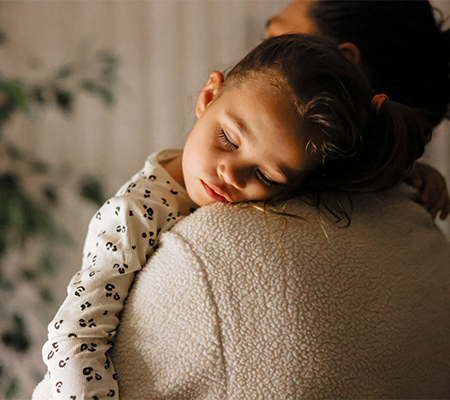Caring for children with RSV, or respiratory syncytial virus, at home can be nerve-wracking. As a common respiratory infection, RSV symptoms may include runny nose, decreased appetite, coughing, sneezing, fever and wheezing. While symptoms typically only last a couple of weeks and resolve with rest and fluids, RSV can be dangerous, especially in infants.
RSV can cause dehydration, trouble breathing and additional serious illnesses, such as lung infections like bronchiolitis or pneumonia, which are often causes of hospitalization in infants.
Tips for caring for RSV at home
“In many cases, RSV will go away on its own. As a parent, you can help treat your child’s symptoms at home as they occur, similar to what you’d do for a bad cold,” said Dr. Thomas Boyce, pediatric infectious disease provider with Marshfield Children’s.

Tips for caring for RSV at home include clearing out mucus and improving breathing. You can help do this through:
- Nasal saline rinses to flush out excess mucus.
- Using a bulb syringe to suction mucus from your child’s nose.
- Using a cool-mist humidifier to help thin mucus to allow it to drain more easily.
Make sure your child gets plenty of rest and stays comfortable. Sleep is essential because it helps their body recover faster and gives their immune system the energy it needs to fight off the virus.
If your child has a fever, consider giving them a fever-reducing medicine. Acetaminophen can be given at any age. Ibuprofen can be given to children six months and older.
Talk to your child’s health care provider about proper medication dosage and if your child has any medication restrictions.
Keeping your child hydrated is important
When your child is sick, they likely aren’t eating and drinking as much as normal. This can increase their risk of dehydration.
Children are more vulnerable to dehydration than adults. Their smaller body size means it doesn’t take as much fluid loss to cause dehydration.
To help reduce the risk of dehydration:
- Try feeding your child more frequently if they aren’t eating as much.
- Using the bulb syringe to help clear their nose before feeding may improve food intake.
- For breastfeeding children, it may help to pump and then feed from a bottle.
- In older children, popsicles, ice chips, soups or Pedialyte may help improve hydration.
Monitor how much your child is drinking.
“If your child is drinking less than normal and if they have fewer than five to six wet diapers daily for infants or no wet diapers or urination for eight hours in toddlers, talk to your child’s provider,” Dr. Boyce said.
Monitor for additional signs of dehydration including sunken eyes, irritability, unusual fatigue, crying with no tears and a dry mouth or tongue.
Know when to see a health care provider for RSV
“If your child is breathing too hard or too fast to feed effectively, they should be brought to the emergency department,” Dr. Boyce said.
Talk with your child’s health care provider if they show other signs of worsening illness including wheezing, persistent irritability and if they are showing signs of dehydration.
Immunizations for RSV are available to help protect your child from severe illness
To help protect newborns, a maternal RSV vaccine is recommended during weeks 32 through 36 of pregnancy. The vaccine can be administered from September to January to help ensure protection for a baby if they are born during peak RSV season.
An immunization is available for infants and young children. It’s recommended for:
- Infants younger than 8 months of age, born to mothers who did not receive a maternal RSV vaccine during pregnancy. This should be given to infants shortly before the RSV season, or within one week after birth, if born during October through March.
- Infants and young children aged 8 – 19 months, who are at an increased risk of severe RSV disease. This includes some children who were born prematurely and have chronic lung disease, are immunocompromised, have severe cystic fibrosis or are of Indian or Alaska Native heritage. This should be given to children between October through March.
Learn more about RSV and how to protect your child.
For questions or concerns, talk to a Marshfield Clinic Health System provider.
Schedule appointment Message your provider
Related Shine365 articles
Kids do gross things like eat boogers and pee in pools: Is it bad?






Leave a Reply